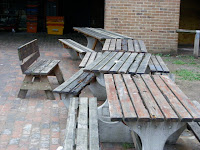Tuesday, 30 March 2010
Tuesday, 1 December 2009
Tuesday, 13 October 2009




Tuesday, 6 October 2009
Hollywood Style
- Clear hero and villain
- expensive sets and costumes
- individuals triumphing over the masses
- obvious story line
- films follow Todorov's theory of narrative
Tuesday, 29 September 2009
Friday, 25 September 2009
Artists and their influence on film makers
Tuesday, 22 September 2009
expressionism
The expressionist movement in Germany originated in the early 20th century, just before the First World War. It sought to express feelings and moods by abandoning naturalism and impressionism in favor of a simplified style that allowed for a greater emotional impact.
In the visual arts, especially print making, German Expressionism was characterised by the use of distorted perspective, geometric shapes, often at unnatural angles and high contrast in the images with the use of a lot of black. In film these features were present in set design, lighting and makeup.
A classic example is The Cabinet of Dr. Caligari (Robert Wiene, 1919) in which the sets are highly stylised and have a dreamlike or nightmarish quality.
In some scenes shadows were painted on to the sets to further exaggerate the distortion and sense of unease.
Make up was also used in the film to make the character of the hypnotised man seem tired and almost corpse like.
The war had been a cataclysmic event. Millions of people died. There was destruction on an industrial scale never seen before in the world. This made a massive impact in Europe and influenced artists profoundly. Nothing was certain any more, civilisation itself appeared to break down and governments could never be trusted again.
This is seen in the film Metropolis (Fritz Lang, 1927) in which the workers are depicted as being pawns of the owners, doing their bidding like machines. This can be compared to the First World War, when the generals sent people to their death like pawns. The machines in the factory swallow up the workers through a giant mouth like the mouth of a beast.
By the 1920’s Freud’s theories were becoming more well known. Freud argued that everyone’s brain was divided up into three parts, the id, the ego and the super ego. The id is the part that contains the basic unconscious drives of the human mind (things like hunger, thirst and sexual desire). The super ego was the part of the brain that creates feelings of guilt and guides us through society, this part is the opposite to the id as it suppresses those primal urges. The ego was reason, acting between the id and the super ego in the real world so that the desires of the id could satisfied in an acceptable manner.
This theory is explored in The Hands of Orlac (G.W. Pabst, 1924), in which a musician loses his hands and gets a transplant from a murderer. Does he control the hands or do they allow him to act out his secret unconscious evil desires ? A striking image from the film shows the musician holding up his hands to the camera as if they are not his own.


